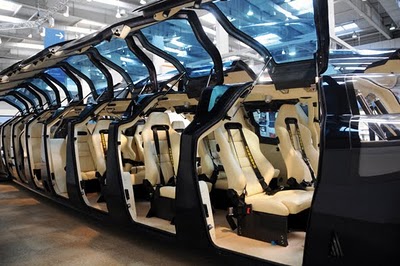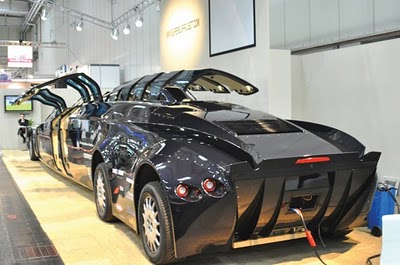


Superbus is as long and wide as a normal bus, but has much lower ground clearance. The structure and body is made of carbon. The aerodynamic shape makes Superbus highly efficient. The electrical vehicle uses at 250 km/h as much energy as a normal bus at 100 km/h. The 23 passengers have a spacious environment with luxury seats, like they drive in an extended limo-sports car. 16 wing doors allow easy access with minimal interference of other passengers.
Superbus service is on demand. Passengers will announce their travel desire via sms or internet. Superbus will group those that want to travel form roughly the same location to roughly the same destination. Superbus can drive on normal roads and roundabouts. Adjacent to the autobahn a special superbus tracks allows for the high speed ride of Superbus. Each 20 km Superbus can switch form and to the normal autobahn lane at a dynamic separation.
The Superbus batteries will give a range of 200 km and will be swapped when empty with full ones using a ‘pit stop’ Superbus performance and potential was studied by the Ministry of Transport in the Netherlands and was compared with High Speed Train and with the Magnetic Levitation Train.
Superbus turned out to be superior on each of the four criteria: passenger attraction, environmental impact, cost of infrastructure and potential profit of the business case. This was the reason that the Ministry gave the funding to the University to design and build a experimental prototype.
Dr. Antonia Terzi, former Chief Aerodynamicist of BMW-Williams F1 was the Chief Vehicle Designer. It took three years from first idea to the present launch and first test ride.
